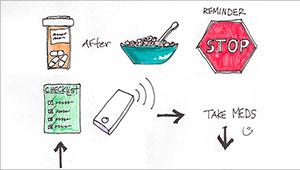Health Informatics
Research overview
Research on health informatics at Kaiser Permanente Washington focuses on developing and using health information technology (IT) to transform health care delivery. By testing new paradigms of care that provide more opportunities to engage patients, this research is supplying valuable evidence that is helping shape federal policy and guiding innovative redesign of health care.
“We’re working to understand how to make health IT practical so patients and care teams find it useful and engaging,” explained Kaiser Permanente Washington Health Research Institute (KPWHRI) Senior Investigator James Ralston, MD, MPH. “We want to find ways to use information technologies to support patients and providers together, both inside and outside the office.”
Integral to this support is designing technologies that are user-friendly and meet the needs of both patients and providers. By applying human-centered methods that focus on needs, use, and usability, KPWHRI researchers inform the design of health IT with direct participation from users.
Groundbreaking methodological work by KPWHRI health informatics researchers includes developing natural language processing (NLP) to analyze text such as notes and written reports in electronic health records (EHRs). Assistant Investigator David Carrell, PhD, leads in the area of using NLP and machine learning to identify patient phenotypes, or specific health characteristics such as possible heart disease, risk of opioid overdose, or suggestion of colon cancer. This information can assist researchers in studying how genetics and other factors influence disease.
Other examples of KPWHRI health informatics research include projects using EHRs and secure electronic communications such as:
- using a patient-shared EHR to improve care for chronic illnesses such as depression, diabetes, hypertension, and heart disease;
- understanding the effects of technologies such as OpenNotes, which gives patients access to notes that their doctors write during office visits;
- understanding and addressing differences in patient use of online health care services that could lead to disparities in care;
- testing NLP to target mentions of specific words and phrases in EHRs to supplement or replace skilled chart abstraction—providing faster access to “big data” and actionable information about patients who may need follow up.
Examples of KPWHRI research in mobile health (mHealth) and user-centered design include:
- evaluating mHealth smartphone tools: 1) to improve primary care for alcohol use disorders, 2) to support patients after bariatric surgery, and 3) to change smoking behavior;
- the VITAL and Seeing Priorities studies to apply user-centered processes to learn how health care providers can elicit and honor what is most important to patients living with multiple chronic health conditions;
- the REMIND project applying user-centered methods to redesign clinical reminders and notifications for patients with chronic and preventive health care needs;
- the landmark Electronic Communications and Blood Pressure (eBP) study of home blood pressure monitoring and web-based care to increase hypertension control without office visits.
“Our studies on using health IT to improve care are showing that we can achieve better outcomes when we shift care from the doctor’s office to where people live: in their homes—and online,” said Senior Investigator Beverly B. Green, MD, MPH.
Recent publications on Health Informatics
Hartzler A, Huh J. Patient power on the web: the multifaceted role of personal health wisdom. In: Wetter TH, editor. Consumer Health Informatics: new services, roles, and responsibilities. Springer, 2015. PubMed
Borthwick KM, Smelser DT, Bock JA, Elmore JR, Ryer EJ, Pacheco JA, Carrell DS, Michalkiewicz M, Thompson WK, Pathak J, Bielinski SJ, Denny JC, Linneman JG, Peissig PL, Kho AN, Gottesman O, Parmar H, Kullo IJ, McCarty CA, Bottinger EP, Larson EB, Jarvik GP, Harley JB, Bajwa T, Franklin DP, Carey DJ, Kuivaniemi H, Tromp G. Ephenotyping for abdominal aortic aneurysm in electronic medical records and genomics network: algorithm development and KonstanzInformation Miner workflow. Intl J Med Biomed Data Min. 2015 Dec;4(1). pii: 113. Epub 2015 Jul 30. PubMed
Larson EB, Tachibana C, Thompson E, Coronado GD, DeBar L, Dember LM, Honda S, Huang SS, Jarvik JG, Nelson C, Septimus E, Simon G, Johnson KE. Trials without tribulations: minimizing the burden of pragmatic research on healthcare systems. Healthc (Amst). 2016 Sep;4(3):138-41. doi: 10.1016/j.hjdsi.2015.07.005. Epub 2015 Jul 29. PubMed
Bielinski SJ, Pathak J, Carrell DS, Takahashi PY, Olson JE, Larson NB, Liu H, Sohn S, Wells QS, Denny JC, Rasmussen-Torvik LJ, Pacheco JA, Jackson KL, Lesnick TG, Gullerud RE, Decker PA, Pereira NL, Ryu E, Dart RA, Peissig P, Linneman JG, Jarvik GP, Larson EB, Bock JA, Tromp GC, de Andrade M, Roger VL. A robust e-epidemiology tool in phenotyping heart failure with differentiation for preserved and reduced ejection fraction: the Electronic Medical Records and Genomics (eMERGE) Network. J Cardiovasc Transl Res. 2015 Jul 21 [Epub ahead of print]. PubMed
Mosley JD, Shaffer CM, Van Driest SL, Weeke PE, Wells QS, Karnes JH, Velez Edwards DR, Wei WQ, Teixeira PL, Bastarache L, Crawford DC, Li R, Manolio TA, Bottinger EP, McCarty CA, Linneman JG, Brilliant MH, Pacheco JA, Thompson W, Chisholm RL, Jarvik GP, Crosslin DR, Carrell DS, Baldwin E, Ralston J, Larson EB, Grafton J, Scrol A, Jouni H, Kullo IJ, Tromp G, Borthwick KM, Kuivaniemi H, Carey DJ, Ritchie MD, Bradford Y, Verma SS, Chute CG, Veluchamy A, Siddiqui MK, Palmer CN, Doney A, MahmoudPour SH, Maitland-van der Zee AH, Morris AD, Denny JC, Roden DM. A genome-wide association study identifies variants in KCNIP4 associated with ACE inhibitor-induced cough. Pharmacogenomics J. 2015 Jul 14. doi: 10.1038/tpj.2015.51. [Epub ahead of print]. PubMed
Researchers in Health Informatics
 Claire Allen, MPHManager, Collaborative Science |
 Katharine A. Bradley, MD, MPHSenior Investigator |
 Yates Coley, PhDAssociate Biostatistics Investigator |
 Beverly B. Green, MD, MPHSenior Investigator |
 Annie Hoopes, MD, MPHAssistant Investigator |
 Paula Lozano, MD, MPHSenior Investigator; Director, ACT Center |
 James D. Ralston, MD, MPHSenior Investigator |
 Brian D. Williamson, PhDAssociate Biostatistics Investigator |









